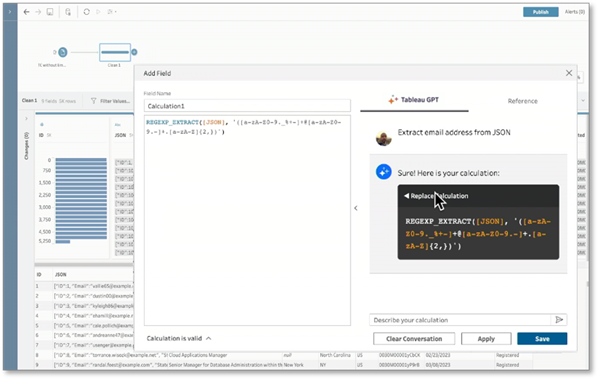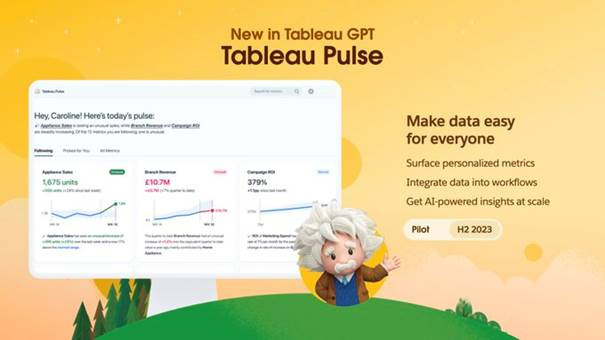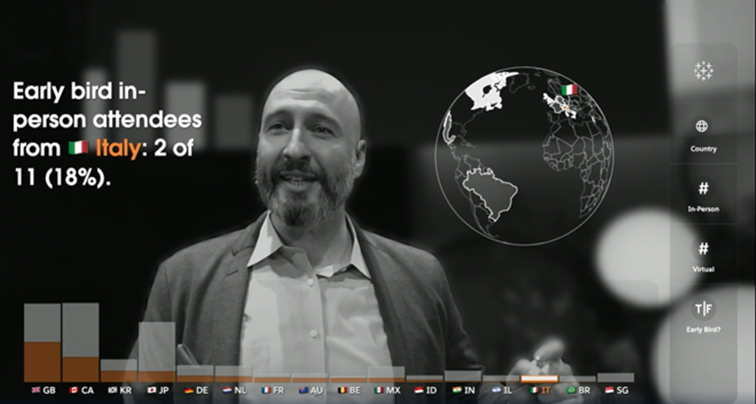Lilacs and chestnuts had already bloomed; so the time came for the Tableau Conference. The one which took place in Las Vegas between 9-11 May 2023 was their twentieth event. Traditionally, Tableau’s latest innovations were announced and this time they stirred the imagination. To name just the two: Tableau GPT and Augmented Reality in Tableau.
Tableau and GPT
Everybody is talking about GPT today, especially about Chat GPT. Questions still arise as to which professions will survive this revolution. How teachers will be able to enforce essay writing skills if the artificial intelligence can create them? Absolutely everyone in the market is wondering how to use this technology to improve their products and gain a competitive advantage. Thus Tableau’s announcement of launching its Tableau GPT did not come as a surprise.
It is necessary to sidetrack here to explain what it means. Tableau GPT is not a Chat GPT implemented in Tableau. It is a completely new tool. GPT is the abbreviation of Generative pre-trained transformer. It is a type of machine language learning model, which is trained on huge datasets to create content, based on the context information provided. However, it is a model, and not a technological solution; therefore it can be trained on a variety of different data. And that’s what Salesforce and Tableau do. Tableau GPT is going to be a language model trained to describe Tableau. What can it be trained on? On Tableau documentation, forum content, knowledge blogs, Tableau Public, etc. There is plenty of materials available. Moreover, Einstein GPT is being developed at the same time. It is more interesting, however, to find out what it is intended to do than why it is here.
Applications of Tableau GPT
At the Tableau Conference, several applications of Tableau GPT planned to be introduced in the coming year were shown. Certainly, these are not going to be the only or the final capabilities of Tableau GPT. The most obvious one is to use Tableau GPT to write code in Tableau Prep. A very good example. Text processing in this case would require several complex operations, or using the REGEX_EXTRACT() function with an appropriate regular expression. Creating such an expression is an art in itself, and requires certain skills and experience. But soon Tableau GPT will be able to suggest the structure of this function.

Tableau GPT will also support the search capabilities of Tableau Cloud. For example, searching for the source of data that will provide the best answer to a business question from all available options. Tableau will not only specify the source, but it will also draw a chart with a suggested answer and show its concise description using simple language. At this point, it is going to be simple English. However, this type of analysis gives more options. With just one click, the user can copy the suggested chart to a newly created workbook to further develop the analysis. Tableau GPT will continue to be available for support in the Data Guide Tab.
When analysing this presentation, I recalled the words of Pablo Picasso, who once said that computers were useless, because they could only give you answers. They could not ask questions. But maybe this is slowly changing, as Tableau GPT in Data Guide proposes questions, answers to which can be found in a given dataset. Tableau Pulse – a new service and new quality offered by Tableau – will feature similar functions.
What capabilities does Tableau Pulse have?

Let’s imagine a simple landing page in Tableau with amazing metrics charts. It’s visually appealing and clear, and it doesn’t require spending hours on formatting. Tempting. And competition already has it. How to make the next step? Tableau, when developing Tableau Pulse, combined the existing metrics function with Tableau GPT. This way they may, but need not, be automatically generated. You can get a description of what may be derived from them. And it’s possible to view further questions that can be answered based on a given dataset. You can also ask your own questions, including wide and open questions, such as “What can you tell me about tables in Sample Superstore?”
Tableau GPT is likely to be the next evolutionary step after Ask Data. Ask Data theoretically allows us to converse with data in a natural language. Theoretically, since it is a model learning how a human being can ask a machine questions to obtain satisfying answers. The final result is these answers, and the learning curve is not too steep, however, it can hardly be called a conversation. The one in Tableau GPT seems to be much more fluent. Language is an additional barrier here. English questions with Polish names of dimensions are unintuitive in Ask Data. Overcoming this barrier is for now a rather distant future, but looking at the changes around us, it does not seem to be unrealistic.
The icing on the cake: Augmented Reality

Out of the announcements made during the Tableau Conference, it was Tableau Gesture that impressed me the most. What does it do? It allows to conduct live data analysis during a conversation in Teams, Hangouts, Webex, or any other instant messenger. You will say: Nothing new. That is true, however, here presenters don’t need to be in the background to share their screen. The analysis is carried out live, and charts are instantly displayed and modelled between the speaker and the audience. You just need a laptop, a webcam and your hands, since you use gestures to illustrate your points with data. Tableau Gesture is an introduction to enhanced reality in Tableau, which until recently has been associated with science-fiction movies only.
Agata Mężyńska
